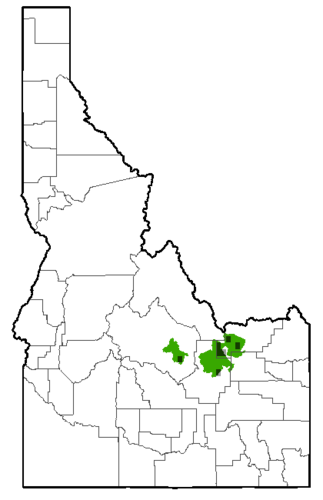Acrolophitus pulchellus - Idaho Point-headed Grasshopper
Acrolophitus pulchellusSpecies Conservation Status Assessment from Idaho State Wildlife Action Plan, https://idfg.idaho.gov/sites/default/files/swap-appendix-f.pdf 2
CONSERVATION STATUS & CLASSIFICATION
ESA: No status
USFS:
Region1: No status
Region 4: No status
BLM: Type 2
IDAPA: Unprotected Wildlife
G-rank: G1G3
S-rank: S2
SGCN TIER: 2
Rationale: Idaho endemic, restricted range, IUCN Vulnerable
DISTRIBUTION & ABUNDANCE
Range Extent in Idaho: 3,800 km2 (~1,500 mi2)
Key Ecological Sections: Beaverhead Mountains, Snake River Basalts
Population Size in Idaho: Not applicable for invertebrates.
Description: The Idaho Point-headed Grasshopper is a rare Idaho endemic found in the Birch Creek and Big Lost River drainages. Prior to 2010, the species was known from only 17 records dating from 1883 to 1993. Surveys in 2010 confirmed its persistence at historical localities.
HABITAT & ECOLOGY
Environmental Specificity: Moderate: Generalist—some key requirements are scarce.
Description: This grasshopper is found in dwarf-shrubland and steppe habitats on alluvial fan and stream terrace landforms characterized by sparse vegetation, surface gravels, vagrant lichens, and intact biological soil crusts. The species is thought to be ground-dwelling and a specialist feeder on stemless mock goldenweed, a cushion–form forb common to the area.
POPULATION TREND
Short-term Trend: Unknown
Long-term Trend: Unknown
Description: Population trends have not been documented.
THREATS
Overall Threat Impact: Unknown
Intrinsic Vulnerability: Highly vulnerable
Description: Threats to these populations are widespread, but low in magnitude, and include invasive plants, OHV use, conversion to agriculture, and improper livestock grazing management. The species is also thought to be negatively influenced by drought.
CONSERVATION ACTIONS
Conservation issues and management actions are described in the Beaverhead Mountains Section plan. In short, recommended strategies for this species include continuing to investigate the ecology of the species and encouraging land management that promotes proper livestock grazing management, restricts OHV travel to designated routes, controls noxious weeds, and uses native species for range restoration.
ADDITIONAL COMMENTS
None.
Information Sources: Waterbury BA. 2014. Rediscovered populations of the Idaho Point–Headed Grasshopper, Acrolophitus pulchellus (Bruner), 1890 (Orthoptera: Acrididae). Western North American Naturalist 74:349–355. Map Sources: Idaho Department of Fish and Game. Idaho Fish and Wildlife Information System, Species Diversity Database. [Accessed July 1, 2014].; Waterbury BA. 2014. Rediscovered populations of the Idaho Point–HeadedGrasshopper, Acrolophitus pulchellus (Bruner), 1890 (Orthoptera: Acrididae). Western North American Naturalist 74:349–
355.
Sources and Credits
- (c) Angie Schmidt, all rights reserved, uploaded by Angie Schmidt
- Adapted by Angie Schmidt from a work by (c) Wikipedia, some rights reserved (CC BY-SA), http://en.wikipedia.org/wiki/Acrolophitus_pulchellus








